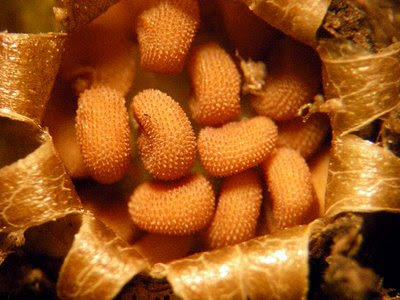







Do you remember the Sesame Street song "One of these Things is Not Like the Others..."? Appropriately enough, the rendition I have linked to is Big Bird singing about bird seed. Why? Because the yummy-looking morsels in the 1st image are wildflower seeds, photographed under the scanning electron microscope (SEM). But only 5 of the other images are actual seeds - 2 of the images show models of micrographed seeds. Scroll down to read the details.
1st image) Seeds of wild flowers photographed by Yanping Wang of Beijing, China, 9th place in the 2010 Olympus BioScapes International Digital Imaging Competition.*
2nd image) Micrograph of a seed from the book Seeds: Time Capsules of Life by Rob Kesseler and Wolfgang Stuppy (out-of-print, but you can buy a used copy here or here).
3rd image) Hairs on seed of Rochelia persica. I haven't been able to source this SEM photo, which appears on the site AboveTopSecret.com.
4th image) Microscopic seed images inspired by Seeds: Time Capsules of Life (new copies available here) and recreated by Nancy Hall and other Australian artists as 3D sculptures using knitting, felt, and clay: Parnassia fimbriata (green), Pholistoma auritum (purple), and Ariocarpus retusus (yellow).
5th image) Seed of a Strelitzia reginae photographed at 10x magnification by Viktor Sykora of Prague, Czech Republic, 5th place in the 2010 Nikon Small World Contest.
6th image) The ripe seed capsule of Silene dioica which has just split open at the tip, with the segments at the apex rolling back to form a ring of teeth with the seeds inside. Microscopic photo taken by Phil Gates in Durham, UK, and featured on his blog Beyond the Human Eye.
7th image) Micrograph of a seed from the book Seeds: Time Capsules of Life by Rob Kesseler and Wolfgang Stuppy (buy a used copy here or here).
8th image) Microscopic seed images inspired by Seeds: Time Capsules of Life and recreated by Nancy Hall and other Australian artists as 3D sculptures using knitting, felt, and clay: Castilleja flava (light yellow), Orthocarpus luteus (yellow), Scutellaria orientalis (purple), and Drosera cistiflora (pink).
How did you do?
*Thanks, Barbara!









No comments:
Post a Comment
You may add your comments here.